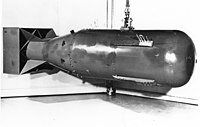
Photo from wikipedia
Abstract Atmospheric fine particulate pollution has been a dramatically environmental concern in all seasons in the megacity Beijing in recent years. A long-term real-time monitoring campaign of non-refractory submicron aerosol… Click to show full abstract
Abstract Atmospheric fine particulate pollution has been a dramatically environmental concern in all seasons in the megacity Beijing in recent years. A long-term real-time monitoring campaign of non-refractory submicron aerosol (NR-PM1) at a southeastern urban site in Beijing from July 13, 2017 to May 26, 2018 using an Aerodyne Aerosol Chemical Speciation Monitor (ACSM) was carried out to investigate the characteristics and evolution processes of NR-PM1 and its potential source effects. The annual average concentration of NR-PM1 during the entire study period was 40.8 μg/m3, lower than that of NR-PM1 from July 2011 to June 2012, and its seasonal variation presented the order of autumn and spring > winter > summer. The average concentration of organic species Org in the entire study was 15.1 μg/m3 and accounted for 37% of NR-PM1, being consistently a significant component of NR-PM1 in the four seasons. The average concentrations of SO42− and NO3− were 8.6 and 11.1 μg/m3, respectively, accounting for 21% and 27% of NR-PM1, and NO3− and its contribution to NR-PM1 exceeded those of SO42−, suggesting that secondary nitrate became a more dramatic pollutant. Note that SO42− in summer accounted for 27% of NR-PM1, higher than those in the other seasons, indicating that secondary sulfate formation was greatly important in summer, however, NO3− in summer accounted for 22% of NR-PM1, lower than those in the other seasons, more likely due to relatively high temperature in summer being favorable for dissociation of nitrate. NH4+ and Cl− species presented lower mass concentrations and mass fractions, and the seasonal variation of NH4+ was similar to NO3−, yet Cl− presented a typical seasonal change related to intense fossil fuel combustion during the heating period in winter and biomass burning in autumn with an order of winter > autumn > spring > summer. All aerosol species exhibited different diurnal cycles, of which Org presented a bimodal mode, SO42− and Cl− showed a flatter diurnal pattern, however, NO3− and NH4+ displayed more similar single-peak patterns. The conversion of SO2 to SO42− presented an obvious seasonal variation with summer > autumn > spring > winter driven by different factors. The conversion of NO2 to NO3− also showed a significant seasonal change characterized by autumn > summer and spring > winter controlled by different factors. Relative humidity, temperature and wind speed during the study period were significant meteorological elements influencing NR-PM1 and its species, and heavy haze pollution episodes largely occurred under high relative humidity and low wind speed. High potential source regions influencing NR-PM1 pollution in Beijing in all seasons presented dramatically distributions related to wind directions.
Journal Title: Atmospheric Environment
Year Published: 2020
Link to full text (if available)
Share on Social Media: Sign Up to like & get
recommendations!